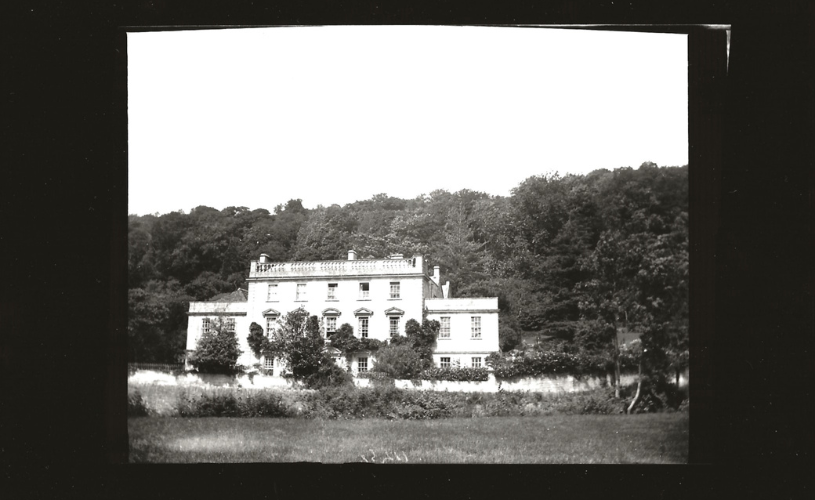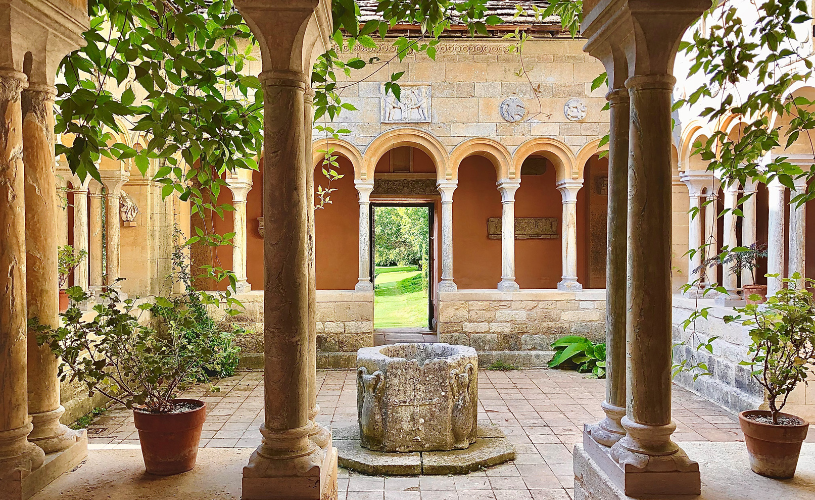Step into another world at Iford Manor Gardens, just outside Bath: for centuries, a place of aesthetic pilgrimage; today, a unique meeting-place for connoisseurs of heritage, gardens, music and epicurean delights.

Image: The Great Terrace at Iford Manor Gardens, credit Marianne Cartwright-Hignett
You know you have arrived at Iford once you see Britannia standing guard on the medieval bridge over the River Frome. Britannia was added in 1910 by renowned landscape architect Harold Peto (partner of Sir Ernest George and mentor to Sir Edwin Lutyens), who lived at Iford from 1899 – 1933. Although Iford has evolved incrementally, it was Peto who largely designed the Grade 1 registered gardens.
Romans settled at Iford and the Italianate nature of the current garden, featuring various Romanesque objects, is reminiscent of that time. Iford Mill existed at the time of Domesday Book and, just as they did back then, sheep continue to graze the valley today. Later home to the de Iford family from the 13th – 15th century, Iford continued as an agricultural holding, but they were also a powerful family of lawyers and held positions including the Prior of Bath (1340 – 1347), Canon of Wells (1342) and even the Common Sergeant of London (1333 – 1353).
The Black Death decimated the area and a resurgence in 1363 saw Nicholas de Iford gift Iford and surrounding lands in Freshford, Limpley Stoke, Westwood, Avoncliff and Woodwick to the monastery at Hinton Charterhouse.
The monks rented the land and the wool trade continued with the Horton family arriving as tenants in the late 15th century. Second generation Thomas Horton became one of the most successful clothiers of all time, and he built many of the buildings seen at Iford today. The Manor originally comprised two buildings – one, a cloth factory and the other a two gabled house on the garden side but the factory was short-lived and became incorporated into the home, as the Hortons had other industrial holdings of greater use.
The Horton family sold Iford in 1625 to Lord and Lady Hungerford of nearby Farleigh Hungerford Castle and Corsham Court. Iford formed part of their lands until 1687 when sold by Sir Edward Hungerford IV ‘the Spendthrift’ to settle his gambling debts, and came to be owned by the Chandler family who joined the buildings together and c. 1720 built the façade that you see today albeit with an extra ‘false wing’ that Harold Peto later removed.

Image: The old original facade of Iford Manor
From 1777 – 1858 the Gaisford family were at Iford. They created the first terraced garden at Iford, incorporating cypresses and other Mediterranean plants, with beautiful views across the valley. In the 1820s they planted the wisteria on the front of the Manor, rumoured to be one of the oldest in the country. By this time, Thomas Gaisford (b. Iford 1779), was Dean of Christchurch, Oxford, and remains even today a regularly referenced classical scholar.
By purchasing their neighbour’s house across the road, which they demolished, they acquired a walled garden, the front area of which can be seen from the bridge. The walled garden is closed to visitors (except on Behind the Scenes tours), but has been subject to major restoration in recent years and today is a productive garden providing vegetables, cut flowers and fruits to the restaurant and adjoining café at Iford.
The Rooke family resided at Iford from 1858 – 1899 and bred racehorses at Iford Manor, with archery practice taking place in the historic Archery Ground opposite the Manor, rumoured to be where archers had trained for the Battle of Agincourt!
In 1899, Harold Peto bought Iford and transformed the garden terraces into the magical spaces that you see today. Influenced strongly by his passion for travel, antiquity and design, he incorporated elements from wide ranging international ideas, objects and buildings into the vernacular English landscape. His Grade II* listed cloister is a particularly special building, and the musical performances in the space during Iford’s jazz festival are uniquely intimate. Iford somehow feels like stepping into another world as a result - ‘outside of time and place.'

Image: The garden cloisters at Iford Manor Gardens, credit Marianne Cartwright-Hignett
Whether it is through inspiration from Roman objects, Peto’s magical design, or more recently through seeing the manor on screen in The Secret Garden, there is much at Iford to capture the imagination. Restored and extended by the Elizabeth Cartwright-Hignett and John Hignett from 1965, the next generation William and Marianne continue to ensure that Iford is a place of beauty and tranquility that can be enjoyed by visitors who leave feeling refreshed and inspired.
Read more
Related
Comments
Comments are disabled for this post.





